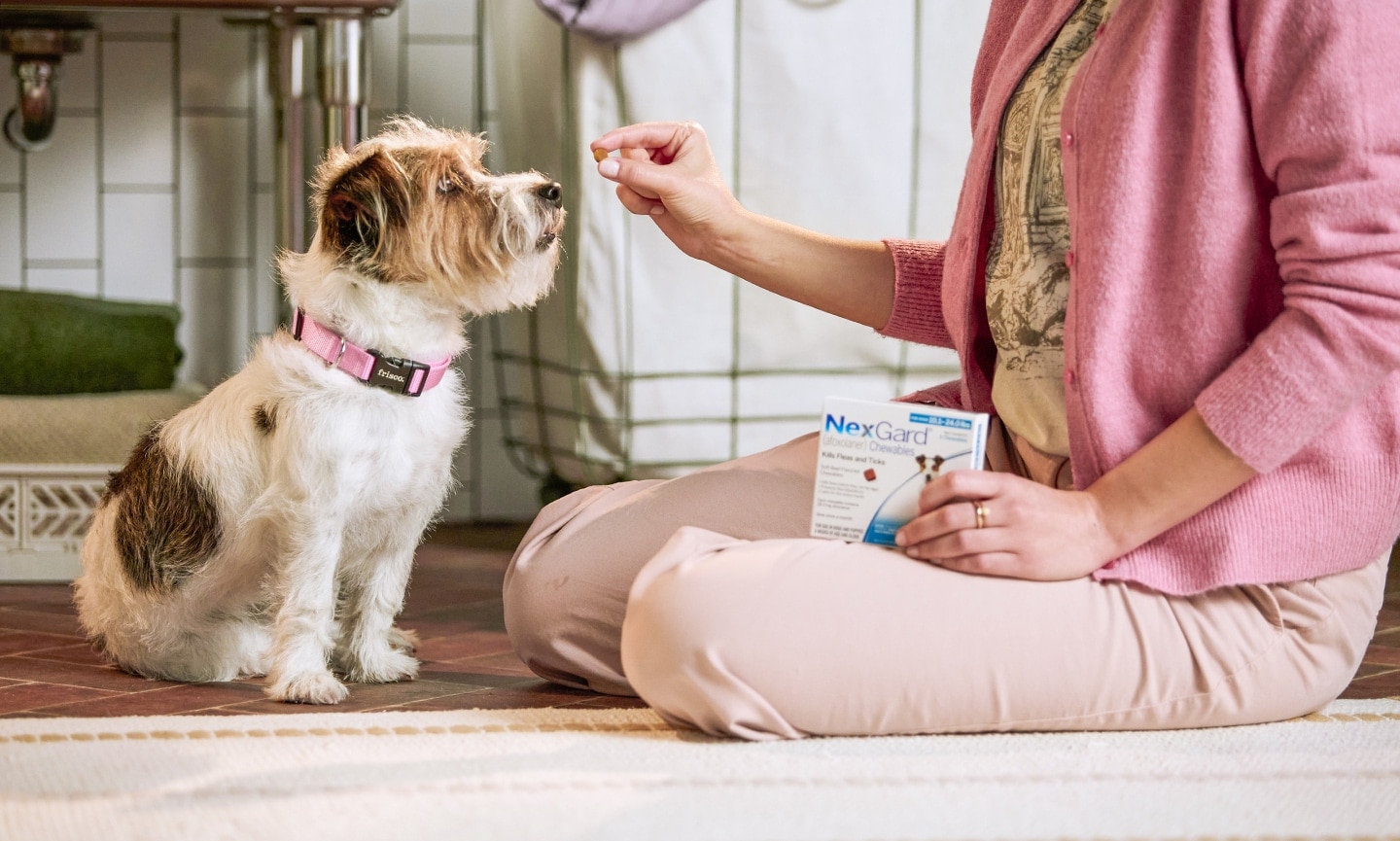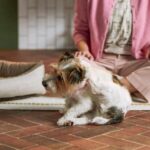A Guide to Flea and Tick Prevention for Puppies

Photo by SolStock/E+ via Getty Images
While you and your puppy are beginning to form an unbreakable bond with plenty of playtime and cozy cuddles, the last thing you might want to think about are parasites. But it’s crucial to prevent the likes of fleas and ticks early on to help keep your best furry friend free of them and, ultimately, healthy and happy for years to come.
We spoke with veterinarians about flea and tick prevention for puppies, including the importance of preventive care, signs your pup may have fleas or ticks, how to treat fleas and ticks on puppies, and more.
The Importance of Tick and Flea Prevention for Puppies
Ticks and fleas are small, pesky pests that can pose big, serious problems for pups.
Starting your puppy on flea and tick prevention early is important for several reasons:
- Health protection: “Fleas and ticks aren’t just annoying—they can transmit serious diseases like Lyme disease, ehrlichiosis, and tapeworms,” says Wayne M. Johnson, VMD, veterinarian at Birdneck Animal Hospital in Virginia Beach, Virginia. “Preventing these pests keeps your puppy safe from these health risks.”
- Comfort: Flea bites cause unpleasant symptoms, like itching, redness, and allergic reactions, while ticks can cause irritation and discomfort, Dr. Johnson explains. By keeping these pests away, you can keep your puppy comfortable and happy.
- Long-term benefits: Regular prevention eliminates the possibility of infestations that can lead to more serious health issues down the line, Dr. Johnson says. Not only that, but it also saves you the hassle and cost of tackling a flea or tick problem in your home.
When Can Puppies Start Flea and Tick Prevention?
Most flea and tick preventives can be started when a puppy is around 8 weeks old, Dr. Johnson says. However, the minimum age may vary depending on the product. For example, the minimum age for puppies to take certain prescription medicines, like Comfortis®, is 14 weeks old, and for Bravecto®, 6 months old.
“It’s best to start flea and tick prevention as soon as your puppy leaves the breeder or shelter,” Dr. Johnson says. “This ensures they’re protected from day one, especially if they’re going to be outdoors or around other animals.”
Always consult with your veterinarian before starting any new medication to make sure it’s safe and appropriate for your puppy’s age, weight, and health status. Your vet will be able to recommend the best timing and approach.
Recommended Products
4 Types of Flea and Tick Prevention for Puppies

Svetlana Parnikova/iStock/Getty Images Plus
There are a few methods you can use to repel and combat fleas and ticks. Of these methods, there are various products to choose from to best accommodate your puppy’s needs and your budget.
Our experts break down the different types of flea and tick medications and methods, as well as their benefits and drawbacks:
1. Prescription Pills and Chews
Available in wag-worthy flavors, prescription pills and chews are often recommended for their systemic action and work by entering the bloodstream and killing fleas or ticks upon biting, says Bethany Hsia, DVM, mobile veterinarian and co-founder of CodaPet, in Clovis, California.
These are typically given once a month, but sometimes every three months, depending on the product. For example, a single NexGard® Plus chew can be given once a month with protection that lasts one month, while a single Bravecto® chew can be given every three months and provide up to three months of protection.
Dr. Johnson considers prescription pills and chews to be effective and convenient, as they tend to kill fleas and ticks quickly and are easy to administer. However, depending on how long they last, they must be given on time and regularly to work effectively. Some puppies may also have digestive upset or other reactions from taking them.
“Vets may suggest these options for puppies who are at least 8 weeks old and weigh enough to safely receive the medication,” Dr. Hsia says.
Recommended Product
2. Topical Treatments
Topical solutions, like Revolution®, are applied directly to the skin and generally offer protection for up to one month, killing adult fleas and preventing flea eggs from hatching.
Topical treatments are easy to apply and provide continuous protection with a single application, Dr. Johnson says. Some topical treatments can also protect against heartworms and other parasites.
In some cases, however, topical treatments can be messy and stain your puppy’s fur, he says. And, if not applied correctly, they may be ineffective against fleas and ticks. (Eek!) Additionally, topical treatments may cause skin reactions if your puppy has sensitive skin.
Topical treatments may be recommended for puppies who might not tolerate oral medications well, Dr. Hsia says.
Recommended Product
3. Collars
A flea collar is worn just like a regular collar, except it kills and repels notorious pests like fleas, ticks, lice, flea larvae, and even mosquitoes.
Flea and tick collars, like the Seresto® collar, provide protection anywhere between six to eight months.
Collars are convenient, long-lasting, and offer constant protection, Dr. Johnson says. However, there are a few drawbacks, including:
- Some puppies might find collars to be uncomfortable or try to chew them, which could lead to choking hazards, irritations, or even injury if the collar gets caught on something. Additionally, constant chewing could weaken the collar, reducing its effectiveness.
- They may not be as effective as other methods for severe infestations.
- They need to be properly fitted to be effective and safe.
“Some veterinarians might recommend collars for ongoing prevention in older puppies or those with minimal exposure to fleas or ticks,” Dr. Hsia says. “However, they should only be used if they are designed specifically for young dogs.”
Puppy collars are safer than adult dog collars for young dogs because they’re sized for a proper fit, contain milder ingredients to protect sensitive skin, and often feature safety mechanisms like breakaway designs to prevent choking.
Recommended Product
4. Shampoos and Combs
Using flea and tick shampoo for puppies is another way to help keep them free from these parasites.
Shampoos, such as the Advantage® flea and tick shampoo, can be used for puppies over 12 weeks old and can kill fleas and ticks on contact. In general, they should be used only once a week.
During or after your pooch’s bath, use a flea comb to remove any fleas that may still be on them.
Dr. Johnson considers flea shampoos to be good for getting rid of existing parasitic pests and great for puppies who can’t take medications. There are also some options that use natural ingredients.
While they do have their benefits, Dr. Johnson says they don’t provide long-term prevention and are not as effective at preventing future infestations compared to other methods. Using a flea shampoo also requires regularly bathing and combing your pet, which can be time-consuming.
Recommended Products
Dr. Johnson shares the following tips on flea and tick treatment for puppies:
- Consistency is key. Whatever method you choose, make sure to stick with it consistently, as directed, to keep your puppy protected.
- Consult your vet. Always talk to your vet first before applying any treatment and to determine the best option that’s tailored to your puppy’s specific needs.
- Monitor for reactions. Keep an eye on your puppy after starting any new treatment to catch any adverse reactions early. If an adverse reaction occurs, seek your vet’s advice on whether to discontinue use or switch to an alternative treatment.
“By staying proactive with flea and tick prevention, you’re ensuring a healthier, happier life for your puppy,” he says. “If you have any more questions or need personalized advice, your vet is always the best resource.”
What Ingredients Are in Flea and Tick Medicine for Puppies?

Chewy Studios
If you’ve ever wondered what’s in your dog’s flea and tick medicine, you’re not alone. Upon reading the ingredients, two questions may come to mind:
- How do you even pronounce that?
- What exactly does this do?
Flea and tick treatment is carefully formulated to eliminate problematic pests and keep them away.
Here are common ingredients in flea and tick medicine for puppies, by treatment type:
Collars
- Deltamethrin: Kills fleas by disrupting nervous system function
- (S)-methoprene: Prevents flea reproduction by interfering with insect growth and development
- Tetrachlorvinphos: Kills fleas by overstimulating the nervous system
Topical Flea Medicine
- Dinotefuran: Kills fleas by overstimulating the nervous system
- Etofenprox: Kills fleas by overstimulating the nervous system
- Fipronil: Eliminates fleas by inhibiting a key neurotransmitter in the pest’s central nervous system
- Fluralaner: Kills fleas by overstimulating the nervous system
- Imidacloprid: Eliminates fleas by inhibiting a key neurotransmitter in the pest’s central nervous system
- Moxidectin: Eliminates fleas by inhibiting a key neurotransmitter in the pest’s central nervous system
- Permethrin: Kills fleas by overstimulating the nervous system
- Pyriproxyfen: Prevents flea reproduction by interfering with insect growth and development
- Selamectin: Kills fleas by disrupting their nervous system and stops reproduction by preventing eggs from hatching
Chewable Flea Tablets
- Afoxolaner: Kills fleas and ticks by overstimulating their nervous system
- Lotilaner: Eliminates fleas by inhibiting a key neurotransmitter in the pest’s central nervous system
- Lufenuron: Interrupts the biosynthesis of chitin (which makes up a flea’s exoskeleton) in flea larvae; ineffective on adult fleas
- Milbemycin oxime: Interrupts the biosynthesis of chitin (which makes up a flea’s exoskeleton) in flea larvae; ineffective on adult fleas
- Nitenpyram: Kills fleas by overstimulating the nervous system
- Sarolaner: Eliminates fleas by inhibiting a key neurotransmitter in the pest’s central nervous system
- Spinosad: Causes rapid death by attacking the adult flea’s nervous system
Signs Your Puppy May Have Fleas or Ticks

Wirestock/iStock/Getty Images Plus
Being able to detect flea and tick warning signs in your puppy is important. That way, you can get them started on a treatment that’s right for them and keep them safe and protected year-round.
If these blood-sucking parasites make their way onto your pup, certain signs and symptoms will make their pesky presence known. These can include:
- Scratching or biting
- Dark brown specks on fur, aka flea dirt
- Dark spots in bedding
- Tapeworms on bedding or around their anus or feces
- A small bump on the skin
- A bullseye-like bite
- Scabs or raised lesions
- Excessive grooming
- Hair loss
- Restlessness
- Hot spots
- Lethargy
- Muscle loss
- Pale gums
- Paralysis
Flea and Tick Treatment for Puppies
If you notice signs of fleas or ticks on your little buddy, it’s best to take immediate action, Dr. Hsia says. She recommends the following steps to eliminate these pests:
- Bathe your puppy using a vet-recommended flea shampoo to help kill adult fleas on contact.
- Use a fine-toothed flea comb to remove adult fleas and their eggs from their fur.
- Wash all bedding, toys, and any areas where the puppy spends time in hot water to eliminate any remaining pests.
Vets may treat existing fleas and ticks with systemic treatments, like prescription medications that kill adult fleas quickly, or make recommendations for ongoing flea control products tailored to your puppy’s age and weight, Dr. Hsia adds.
FAQs About Flea and Tick Prevention for Puppies
What flea and tick treatment is safe for puppies?
Many topical treatments are safe once puppies reach 8 weeks of age, and oral medications, like chewable tablets, are often safe after 8 weeks of age as well, Dr. Hsia says.
Are flea and tick collars safe for puppies?
Dr. Hsia recommends avoiding flea and tick collars that contain chemicals that may not be safe for young puppies or products containing permethrin.
Can I use a homemade flea shampoo for puppies?
Technically, yes, you can use a homemade flea shampoo as long as you’re using puppy-safe, gentle ingredients, such as coconut oil, a small amount of gentle dish soap, or oatmeal, Dr. Johnson says. It’s also best to consult your veterinarian first.
While flea shampoos can help manage fleas temporarily, Dr. Johnson notes that they might not be as effective as commercial products in preventing future infestations.


















